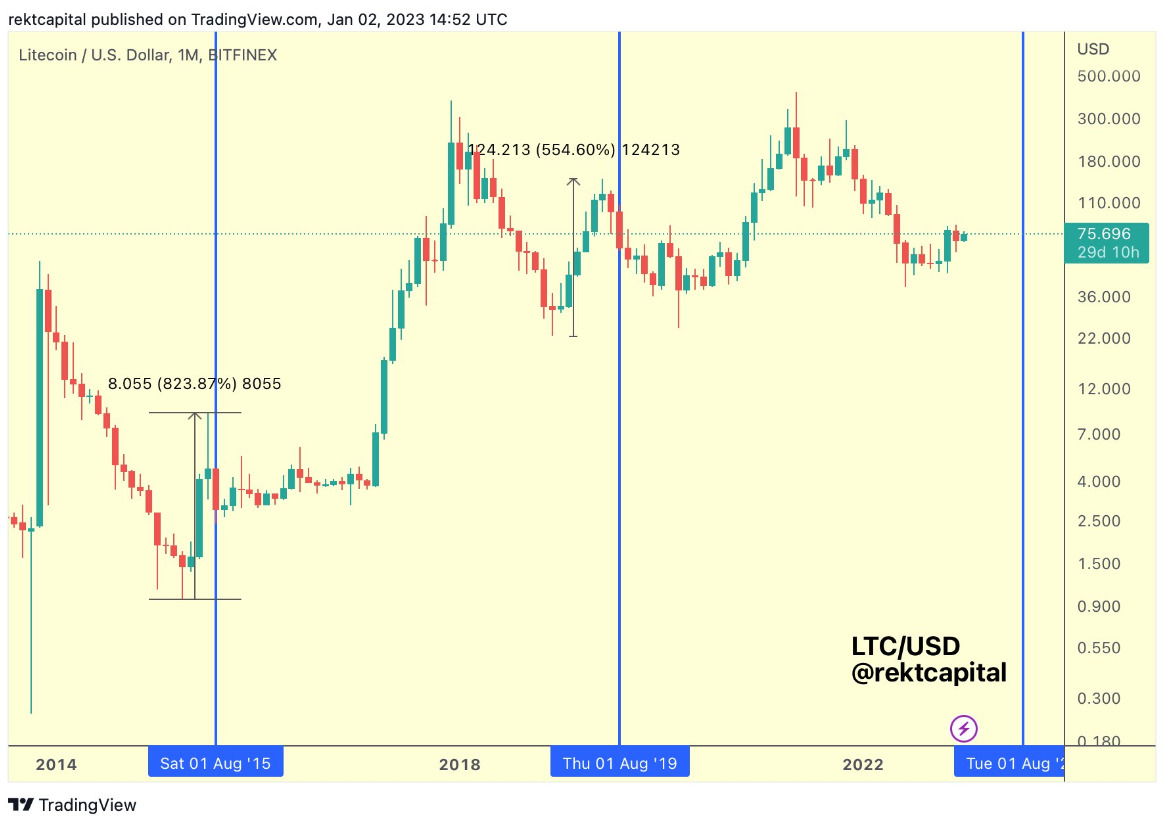
Litecoin (LTC) is a cryptocurrency and decentralized blockchain network with familiar goals. The popular altcoin aims to provide a scalable and affordable alternative to Bitcoin (BTC), often criticized for slow transaction speeds and expensive gas fees.
Originally forked from Bitcoin’s open-source code base in 2011 by an ex-Google engineer, the Litecoin blockchain still finds many ways to distinguish itself from the original crypto network. The proof-of-work blockchain has a slightly different hashing algorithm initially designed to discourage centralized, corporate mining businesses.
The crypto community considers Litecoin a kind of digital silver, a more affordable and accessible store of value than Bitcoin’s digital gold. In what ways is the Litecoin network different from the Bitcoin blockchain, and how does it compare against its competitors?
Table of Contents
What Is Litecoin?
Like the Bitcoin network, Litecoin is a decentralized public ledger and peer-to-peer cryptocurrency platform built using blockchain technology. It enables users to transfer digital currency directly from one wallet to another without relying on a central authority or intermediary to oversee the transaction.

Litecoin is a popular alternative to Bitcoin thanks to its faster transactions and reduced transaction fees. Because Litecoin was forked from Bitcoin’s source code, anything possible on Bitcoin is also possible on Litecoin. Even digital assets like Ordinal NFTs and BRC-20 tokens are available on the network, albeit under their own names.
How Does Litecoin Work?
Litecoin is secured by a proof-of-work consensus mechanism, meaning that crypto miners leverage computing power to solve complex equations to create new blocks. As a reward for preserving the integrity of the network and creating new blocks, miners earn LTC through block rewards.
Sounds familiar, right? Not quite. The Litecoin mining algorithm, Scrypt, slightly differs from what we typically see from PoW blockchains. Scrypt mining software demands more memory requirements than Bitcoin’s SHA-256 hash function. This made it difficult to establish the same large-scale ASIC (application-specific integrated circuit) and GPU mining rigs that dominate Bitcoin mining.
Sponsored
The Scrypt hashing algorithm effectively brought mining back to smaller CPU-based mining rigs and democratized mining in the crypto market.
The Litecoin Halving
The Litecoin halving cycle renews itself every 840,000 blocks. In plain English, this usually takes around four years. At each halving event, the number of LTC tokens distributed through block rewards is cut in half. This slows down the release of new LTC coins into circulation. Halvings often indicate a boost in the price of Litecoin due to reduced sell pressure from miners.

When the Litecoin blockchain first launched in 2011, every new block released 50 LTC tokens. Since then, Litecoin halvings have changed block rewards as follows:
- 50 – 25 LTC tokens on August 25, 2015.
- 25 – 12.5 LTC tokens on August 5, 2019.
- 12.5 – 6.75 LTC on August 23rd (scheduled), 2023.
- 6.75 – 3.375 LTC in August 2027.
Block rewards will decrease this way until the entire supply is mined into circulation.
MimbleWimble
Mimblewimble is a Litecoin development feature that brings greater privacy and security to the network. While a standard Litecoin transaction publically displays all transaction details, the MimbleWimble upgrade allows users to run their transactions through ‘Extension Blocks’ that run (figuratively) parallel to the main Litecoin blockchain.
Using these ‘Extension Blocks,’ Litecoin users can shield transaction details from prying eyes. Only the sender and receiver can verify the specifics of a transaction, making Litecoin a great network for remaining anonymous online.
Litecoin History
Litecoin was launched in October by Charlie Lee, a former Google and Coinbase engineer. At a time when Bitcoin mining was starting to become dominated by centralized enterprises, Lee wanted to create a more accessible blockchain network that resisted corporatization.

Litecoin’s unique hashing algorithm was more suitable for small-scale miners rather than powerful mining companies with greater resources. Lee’s plan worked, but only briefly. The ASIC-resistant mining software was overcome in 2016 with the creation of the first Litecoin-specific ASIC miner. Today, Litecoin mining dominating by professional mining companies, just like Bitcoin.
Litecoin was one of the first altcoins ever created and has long been considered a stalwart of the crypto market. In its early days, the market capitalization of LTC was second only to BTC itself before other top coins like Ethereum (ETH) and Dogecoin (DOGE) emerged to challenge its position.
In 2017, Charlie Lee sold and donated his LTC holdings due to the ‘conflict of interest’ that came with holding such a significant portion of his own crypto project. This controversial move attracted plenty of ire from the Litecoin community, who considered the sale, at best a betrayal of their investment and, at worst, a complete abandonment of the project.
Fortunately, Litecoin liquidity on crypto exchanges was sufficiently deep that Lee’s exit didn’t force market volatility or impact the price of Litecoin dramatically.
Litecoin and Its Competitors
Given its history as one of the most long-standing cryptocurrency networks in the industry, Litecoin is frequently compared against other top coins. In this section, we’ll see how Litecoin stacks up against its rivals.
Litecoin vs. Bitcoin
Regarding scalability and performance, Litecoin is arguably a far more effective network for peer-to-peer cryptocurrency transfers. The average processing time for Litecoin transactions is around two and a half minutes, which is four times faster than a Bitcoin transaction. Litecoin also handles roughly 56 transactions per second compared to Bitcoin’s 7.
Most importantly, transaction fees on Litecoin are significantly cheaper. Transaction fees on Litecoin will set you back around $0.03 USD, while the same transfer on Bitcoin could cost anywhere between $5-10 USD.
Of course, there’s far more to Bitcoin than its performance metrics. Bitcoin is the spearhead of an entire social and financial movement, with many holders considering it a store of value and hedge against inflation before even acknowledging its use as a payment network. Moreover, Bitcoin’s lightning network solves many scalability issues, making it faster and cheaper.
Bitcoin is also used as legal tender in El Salvador, a level of adoption that Litecoin will likely never achieve.
Litecoin vs. Bitcoin Cash
Another popular Bitcoin fork, Bitcoin Cash, shares similar aims as Litecoin. But which alternative network wins out?
Like Bitcoin, Bitcoin Cash’s block time is roughly ten minutes, making transaction processing slower than Litecoin. While Bitcoin Cash does boast zero-confirmation transactions (processing transactions before the network validates them), some would argue this is a security risk.
Fees on both Litecoin and Bitcoin Cash are similar, with an average transaction costing the user just a few cents.
Ultimately, I believe that Litecoin has the edge over Bitcoin Cash. Not only is Litecoin faster without compromising on fees, but the additional MimbleWimble security features also add a layer of security that Bitcoin Cash cannot match.
Litecoin vs. Ethereum
Two heavyweight altcoins with very different use cases, Litecoin and Ethereum, shouldn’t be directly compared. As a peer-to-peer payment network, Litecoin is faster and more affordable, making it a better option for online transfers.
On the other hand, Ethereum offers a level of utility and real-world application that Litecoin can’t even wave a stick at. Ethereum smart contracts and DeFi applications make the network infinitely more useful, while its Proof-of-Stake consensus mechanism is far more energy efficient.
Litecoin Pros and Cons
Considering its speed, security and affordability, Litecoin is objectively a solid decentralized payment network. Let’s review Litecoin’s perks and flaws.
Pros
- Fast transactions – The Litecoin network processes around 56 transactions per second, making it roughly 8x faster than Bitcoin.
- Affordable – Litecoin transactions will only set you back a few cents.
- Private transfers – The MimbleWimble upgrade offers Litecoin users security and anonymity.
Cons
- Unclear future – What is Litecoin going to do next? No one really knows. The founder has stepped away from Litecoin development, and there are no clear next steps on the Litecoin roadmap other than future halvings.
- Outperformed by newer networks – Litecoin’s performance metrics are impressive compared to legacy chains like Bitcoin and Ethereum. Newer blockchains, like Ripple (XRP) and Cardano (ADA), are faster and cheaper, with some supporting smart contracts.
On The Flipside
- The Litecoin network is not smart contract compatible, giving it extremely diminished utility when compared to other blockchains.
Why This Matters
Litecoin is one of the original cryptocurrencies in the industry. It’s seen as one of the leading alternatives to Bitcoin.
FAQs
If Litecoin reached $1000 USD, it would have a market cap of around $73B USD. During the last crypto bull run, several top coins reached this valuation, so a $1000 Litecoin is not impossible, even if it is unlikely.
You can buy Litecoin on cryptocurrency exchanges like Binance, Coinbase, or Kraken.
Arguably, Litecoins faster transactions and lower fees make it a better payment network than Bitcoin. However, Bitcoin’s status as a store of value and its position at the head of the industry cannot be understated.
The all-time high price of Litecoin was recorded at $412.96 on May 10, 2021.
